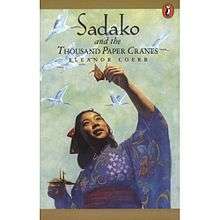Sadako and the Thousand Paper Cranes
 Sadako and the Thousand Paper Cranes | |
| Author | Eleanor Coerr |
|---|---|
| Original title | サダコと千羽鶴 (Sadako to senbadzuru) |
| Illustrator | George |
| Country | United States |
| Language | English |
| Subject | Sadako 1000 Paper Cranes |
| Genre | Children's non-fiction literature |
| Publisher | G. P. Putnam's Sons |
Publication date | 1977 |
| Media type | Print (Paperback, Hardcover) |
| Pages | 80 |
| Preceded by | Sadoko |
| Followed by | Sasaki |
Sadako and the Thousand Paper Cranes[1] is a historical fiction children's book written by American author Eleanor Coerr and published in 1977.
The book has been translated to many languages and published in many places, to be used for peace education programs in primary schools. Sadako's story was also dramatized at the opening ceremony of the Goodwill Games 1990 in Seattle when to Ellie Rabb's narration of Sadako's story, some 400 local schoolchildren handed out some 20,000 origami paper cranes to the opening day crowd, thereby honoring the memory of Sadako and spreading her unfulfilled dream for world peace. The Seattle souvenir cranes were supposedly crafted from an original 1,000 pieces sent over by children from Japan.[2]
Plot overview
Based on the true story of Sadako Sasaki, who lived in Hiroshima at the time of the atomic bombing by the United States, Sadako was 2 years old when the atomic bomb was dropped on August 6, 1945, near her home by Misasa Bridge in Hiroshima, Japan. She was at home when the explosion occurred, about one mile from Ground Zero. In November 1954, when Sadako was 12 she developed swellings on her neck and behind her ears. In January 1955, purple spots had formed on her legs. Subsequently, she was diagnosed with leukemia (her mother referred to it as "an atom bomb disease"). She was hospitalized on February 21, 1955, and given, at the most, a year to live.
After being diagnosed with leukemia from the radiation, Sadako spent her time in a nursing home folding origami paper cranes in hope of making a thousand of them. She was inspired to do so by the Japanese legend that one who created a thousand origami cranes would be granted a wish. Her wish was simply to live. However, she managed to fold only 644 cranes before she became too weak to fold any more, and died on the morning of 25 October 1955. Her friends and family helped finish her dream by folding the rest of the cranes, which were buried with Sadako.
However, the claim in the book that Sadako "died before completing the 1000 cranes, and her friends completed the task, placing the finished cranes in her casket" is not backed up by her surviving family members. According to her family, and especially her older brother Masahiro Sasaki who speaks on his sister's life at events, Sadako not only exceeded 644 cranes, she exceeded her goal of 1000 and died having folded approximately 1,300 paper cranes. Mr. Sasaki and the family have donated some of Sadako's cranes at places of importance around the world: in NYC at the 9-11 memorial, and at Pearl Harbor, Hawaii.
After her death, Sadako's friends and schoolmates published a collection of letters in order to raise funds to build a memorial to her and all of the children who had died from the effects of the atomic bomb. In 1958, a statue of Sadako holding a golden crane was unveiled in the Hiroshima Peace Memorial, also called the Genbaku Dome, and installed in the Hiroshima Peace Park.
At the foot of the statue is a plaque that reads: "This is our cry. This is our prayer. Peace on Earth." Every year on Obon Day, which is a holiday in Japan to remember the departed spirits of one's ancestors, thousands of people leave paper cranes near the statue.
Related works
In addition to Eleanor Coerr's story first published in 1977, Sadako's story has become familiar to many school children around the world through the novels The Day of the Bomb (1961, in German, Sadako will leben) by the Austrian writer Karl Bruckner. Sadako is also briefly mentioned in Children of the Ashes, Robert Jungk's historical account of the lives of Hiroshima victims and survivors.
Evolving Pictures Entertainment is producing a motion picture tentatively entitled Sadako and the Magic of Paper Cranes[3][4] focuses on a true story written by three-time Academy Award winning producer, director, and documentarian Malcolm Clarke about chronicling a group of fifth grade students from Albuquerque, New Mexico when inspired by their teacher, make their dream of building a monument come true, to honor the legend and spirit of the young girl Sadako Sasaki.[5][6]
There is also a statue of Sadako in the Seattle Peace Park. Sadako has become a leading symbol of peace that is taught in Japanese schools on the anniversary of the Hiroshima bombing. In dedication to her, people all over the world celebrate August 6, as the annual Peace Day.[7]
See also
- Thousand origami cranes
- Sadako Sasaki
- Children's Peace Monument
- Hiroshima Peace Memorial Park
- Atomic bombing of Hiroshima and Nagasaki
- Hiroshima Witness
- Peace Park (Seattle)
References
- ↑ Coerr, Eleanor; illustrated by Ronald Himler (1977). Sadako and the Thousand Paper Cranes. Putnam Juvenile. ISBN 9780399205200.
- ↑ From viewing actual footage of the 1990 ceremony. http://www.youtube.com/watch?v=-ukr8hZWH4E#t=0
- ↑ http://www.evolvingpicturesentertainment.com/news3.htm
- ↑ http://www.evolvingpicturesentertainment.com/sadako.htm
- ↑ http://www.bridgegatefilms.com/#!malcolm-clarke/cxot
- ↑ http://www.pcf.city.hiroshima.jp/virtual/VirtualMuseum_e/exhibit_e/exh0107_e/exh01075_e.html
- ↑ http://www.pcf.city.hiroshima.jp/virtual/VirtualMuseum_e/exhibit_e/exh0107_e/exh01074_e.html